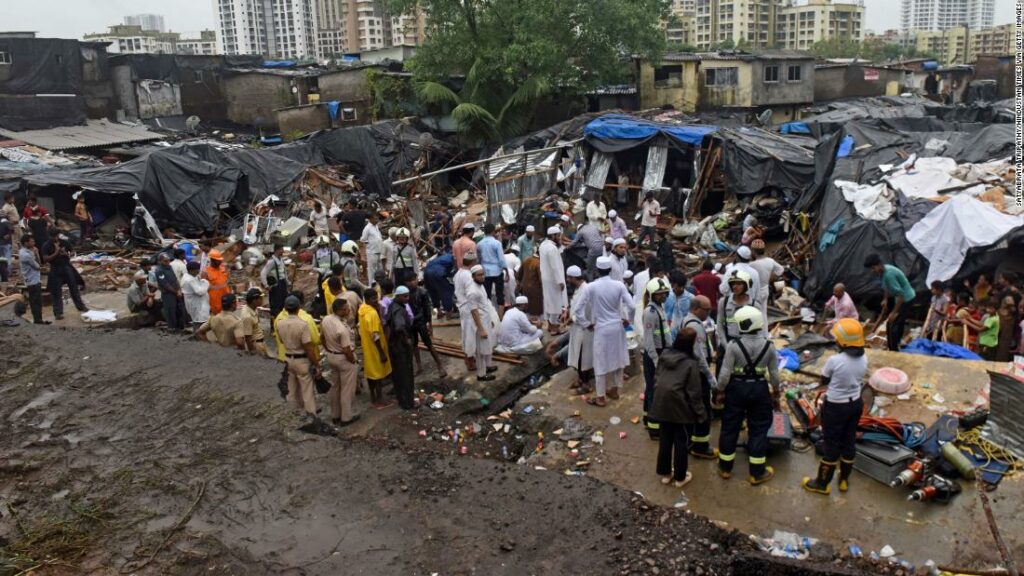Extreme weather destroyed his home four times in three years

A concrete retaining wall that had previously held back monsoon floodwaters had collapsed, sending a deluge through Yadav’s slum in Malad, a northern suburb in India’s financial hub Mumbai.”We woke up to people screaming for help,” said Yadav, 26, of that night in July 2019. “The water had risen to our heads … and I saw people being swept away with the water with my own eyes.”For his entire life, the wall had protected Yadav and his neighbors from increasingly severe monsoon storms. His house had never been damaged before — but with the wall now gone, he has had to rebuild his home four times in three years.Family members started keeping what scarce valuables they had in plastic bags, so they could evacuate quickly. But there’s only so much you can protect.During the 2020 monsoon season, Yadav and his mother once again lost their home, clothing and precious food items to rain and flooding. It happened again in May this year, when a massive cyclone hit India’s west coast — an unusual event, since they typically strike the east coast.Yadav said at that point, people were fed up with authorities and the constant cycle of destruction, evacuation and rebuilding. “How can we live this way?” he said.The most recent disaster came in September, at the tail end of this year’s monsoon season, when debris from past flooding swept toward the slum. “It was around 1:30 in the (morning) and debris started flowing down,” Yadav said. “It was raining heavily and we heard it moving.”span{color:#C5C5C5;}
]]>
A flood tears through the Ambedkar Nagar slum near Mumbai, India, in September 2021. Credit: Anish Yadav
Residents were again evacuated to the school, where they remain to this day with little clean water or electricity and no toilets.”We have no idea when we will go back or get another home,” Yadav said.”(Authorities) are just saying that we will get housing in three to four days, but nothing is being done. People have lost their jobs and they don’t have money for food. The system is to blame here.”The Brihanmumbai Municipal Corporation, Mumbai’s governing body, did not respond to repeated requests for comment.Places are becoming unlivableAs the climate crisis worsens, floods pose a particular danger to the 35% of India’s population — roughly 472 million people — who live in urban slums, according to the And though the government is now training cities across India to become “climate smart,” experts say there are many other measures that need to be taken — like improving evacuation processes and redesigning water systems and other urban infrastructure.Narain, from the Centre for Science and Environment, said existing systems were built “at a time when disasters were still once in 10 years, once in five years. Now, it is 10 disasters a year.”Recent floods, droughts and other devastating climate events are “all showing us very clearly what will the future be,” she added.Climate migrantsFor years, climate experts and scientists have warned the climate crisis could displace more than a billion people in the coming decades — potentially forming a class of “climate migrants” and refugees. Flooding is one of the major dangers, with record rainfall causing devastation in Germany and China this summer.In India, people are already on the move.Natural disasters forced more than 5 million Indians to leave their homes in 2019, according to a study conducted by the Sydney-based Institute for Economics and Peace. And that number is expected to rise as the climate crisis worsens.Many of those displaced Indians, like Yadav, have no means to relocate and no choice but to continually rebuild their homes in disaster-prone locations.Yadav and his family are reluctant to move from their patch of land in the slum, unless the government provides an alternative. He and his mother are now surviving off their meager savings, money borrowed from relatives, and cash earned from pawning their jewelry. Right now, he’s losing hope and dreading the thought of having to rebuild — yet again.”It has been going on for so long,” Yadav said. “You never know if the water will flood the house and destroy the house.”







